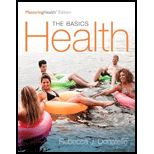
Health: The Basics, The Mastering Health Edition (12th Edition)
12th Edition
ISBN: 9780134183268
Author: Rebecca J. Donatelle
Publisher: PEARSON
expand_more
expand_more
format_list_bulleted
Question
Chapter 12, Problem 3PQA
Summary Introduction
To determine: The correct statement regarding the prevention and treatment of diabetes.
Introduction:
Diabetes mellitus refers to a group of diseases. However, all the diseases are characterized by one factor “high level of glucose in the body”. This refers to a high level of sugar in the body.
Expert Solution & Answer
Want to see the full answer?
Check out a sample textbook solution
Chapter 12 Solutions
Health: The Basics, The Mastering Health Edition (12th Edition)
Ch. 12 - How do we determine whether a behavior or...Ch. 12 - Do you think that there should be legislation...Ch. 12 - Prob. 1PQCh. 12 - Prob. 2PQCh. 12 - Prob. 3PQCh. 12 - Prob. 4PQCh. 12 - Prob. 5PQCh. 12 - Prob. 6PQCh. 12 - When cancer cells have metastasized, a. they have...Ch. 12 - One of the biggest factors in increased risk for...
Ch. 12 - Prob. 9PQCh. 12 - Prob. 10PQCh. 12 - Prob. 1TAICh. 12 - Prob. 2TAICh. 12 - Prob. 3TAICh. 12 - Prob. 4TAICh. 12 - Prob. 5TAICh. 12 - What accounts for the improvement in 5-year...Ch. 12 - Prob. 7TAICh. 12 - Prob. 8TAICh. 12 - What are the differences between carcinomas,...Ch. 12 - Do any of your primary relatives (parents,...Ch. 12 - Prob. 2AYCh. 12 - Prob. 3AYCh. 12 - Prob. 4AYCh. 12 - Prob. 5AYCh. 12 - Prob. 6AYCh. 12 - Prob. 7AYCh. 12 - Prob. 8AYCh. 12 - Prob. 9AYCh. 12 - Prob. 10AYCh. 12 - Prob. 11AYCh. 12 - Prob. 12AYCh. 12 - Prob. 13AYCh. 12 - Prob. 14AYCh. 12 - Prob. 15AYCh. 12 - Prob. 16AYCh. 12 - Prob. 1PQACh. 12 - Prob. 2PQACh. 12 - Prob. 3PQA
Knowledge Booster
Similar questions
- 6. Which of the following can be classified as a prerenal condition? 1. Heart failure 2. Intratubular obstruction 3. Bladder outlet obstruction 4. Hypovolemia A. 2 only B. 4 only C. 2 and 3 only D. 1 and 4 onlyarrow_forwardDuring the absorptive state, glucose levels are ________, insulin levels are ________, and glucagon levels ________. a. high; low; stay the same b. low; low; stay the same c. high; high; are high d. high; high; are lowarrow_forwardIn adults, too much __________ can cause acromegaly. a. melatonin b. cortisol c. insulin d. growth hormonearrow_forward
Recommended textbooks for you
- Essentials of Pharmacology for Health ProfessionsNursingISBN:9781305441620Author:WOODROWPublisher:Cengage
 Nutrition Through The Life CycleHealth & NutritionISBN:9781337919333Author:Brown, Judith E.Publisher:Cengage Learning,Lifetime Physical Fitness & WellnessHealth & NutritionISBN:9781337677509Author:HOEGERPublisher:Cengage
Nutrition Through The Life CycleHealth & NutritionISBN:9781337919333Author:Brown, Judith E.Publisher:Cengage Learning,Lifetime Physical Fitness & WellnessHealth & NutritionISBN:9781337677509Author:HOEGERPublisher:Cengage


Essentials of Pharmacology for Health Professions
Nursing
ISBN:9781305441620
Author:WOODROW
Publisher:Cengage


Nutrition Through The Life Cycle
Health & Nutrition
ISBN:9781337919333
Author:Brown, Judith E.
Publisher:Cengage Learning,

Lifetime Physical Fitness & Wellness
Health & Nutrition
ISBN:9781337677509
Author:HOEGER
Publisher:Cengage
